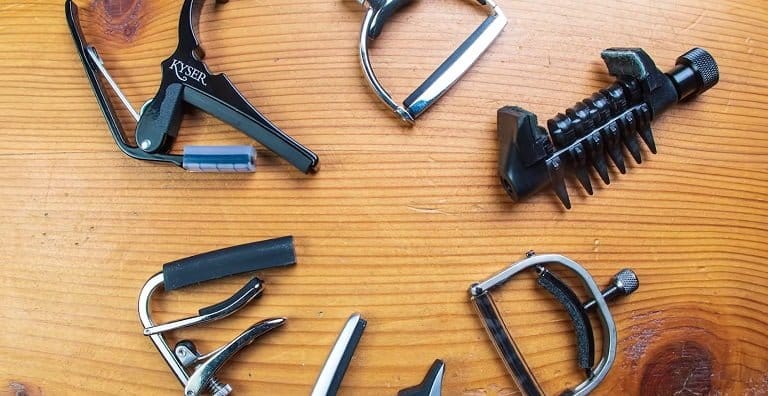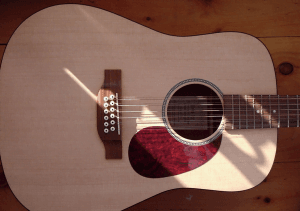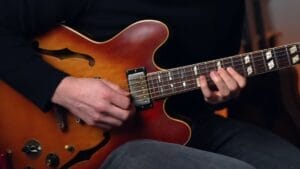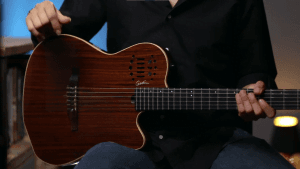Table of Contents
The classical guitar capo is an indispensable accessory that can greatly enhance the playing experience for classical guitarists. Although all capos can be used for steel string acoustic guitars, electric guitars, flamenco guitars, and classical guitars alike, we will look into the little nuances that set them apart.
In this article, I have covered numerous benefits of a classical guitar capo while exploring the crucial considerations that must be taken into account. Furthermore, we will address the potential issues that can arise if a capo is not used properly.
Check out other must-have classical guitar accessories here.
What is Capo?
A guitar capo is a small device you put on the neck of a guitar. It helps change the pitch of the strings by pressing them down on a specific fret. This allows you to play the same chords but in a higher key or different tone, making it easier to sing or play along with other instruments.
It’s like a musical clamp for the guitar neck that helps you play in different keys. Capos are typically used by guitarists of all levels of experience, from beginners to professionals.
Our Top Pick
There are numerous options on the market for buying the best classical guitar capo, which allows you to play the guitar without changing the position of your fingers. But If you value simplicity of usage and consistency, especially in live situations, the G7th Capos or G7th Performance 2 Classical Guitar Capo may be the finest options.
Recommended Brands for Classical Capo
These are some of the capos that I believe are the best for use, based on market research and Bettermuseek artist reviews, as well as my personal experiences.
G7th Performance 2 Classical Guitar Capo
The G7th Performance 2 Classical Guitar Capo is a popular choice among classical guitarists for its ease of use, secure clamping, and ability to maintain tuning stability. It features a unique tension control mechanism that allows for precise adjustment of the pressure applied to the strings, ensuring that they are not over-clamped and that the guitar stays in tune.
Check out our list of best classical tuners to tune your guitar perfectly.

Reason to Buy
Ease of Use: The G7th Performance 2 is renowned for its user-friendly design. It can be easily applied and adjusted with one hand, making it convenient for quick changes during performances or practice sessions.
No Impact on Tuning: This capo is engineered to apply even pressure across the fretboard, which minimizes the chances of detuning. Many capos can pull strings out of tune, especially on the classical guitar’s wider, flat fretboard. The G7th Performance 2’s design ensures minimal interference with the strings’ natural tension, maintaining the guitar’s tuning stability.
Having trouble restringing your classical guitar? Click here for the solution!
Protects the Instrument: The capo is designed with protective materials that safeguard the guitar’s neck and fretboard. It avoids any scratching or damage to the finish of the guitar, which is a crucial consideration for classical guitars that often have delicate finishes.
Reason to Avoid
Size and Weight: While it’s not overly bulky, the G7th Performance 2 is somewhat larger and heavier than simpler capo designs.
Ernie Ball Axis Capo
The Ernie Ball Axis Capo is designed to be a versatile solution for all your guitars. It has a unique reversible design that works well with both flat and radiused fretboards, ensuring that it stays securely in place regardless of the guitar’s fretboard shape. It’s a favorite among guitarists because it fits a wide range of fretboard widths, from ukuleles to 7-string guitars. If you switch between different guitars, the Ernie Ball Axis capo is worth giving a shot.
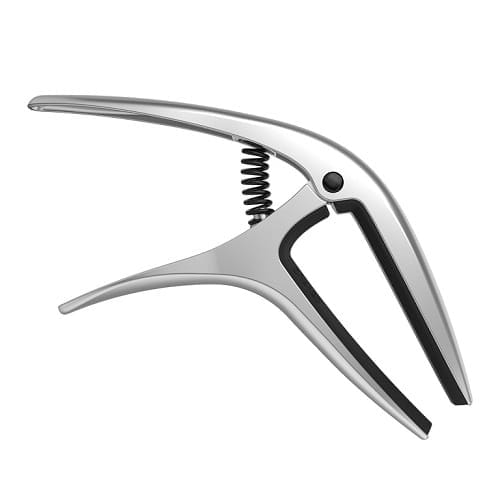
Reasons to buy
Versatile Design: The Ernie Ball Axis Capo boasts a versatile design that can fit various types of guitars. Whether you have a standard six-string guitar, a 12-string guitar, or even a ukulele, this capo is designed to accommodate them all.
Reversible for Different Fretboards: One standout feature of the Axis Capo is its reversible design. It can be used on both flat and radiused fretboards with ease.
Accuracy: Provides clean and accurate sound
Reason to Avoid
Can be a bit stiff: This can make it difficult to use quickly and easily.
D’Addario NS Classical Capo
The G7th Performance 2 Classical Guitar Capo is a specialized accessory for classical guitarists. It minimizes the amount of force necessary to open and shut the capo while maintaining consistent tension independent of the neck profile. It’s designed to offer precision, ease of use, and minimal impact on the instrument’s tonality.
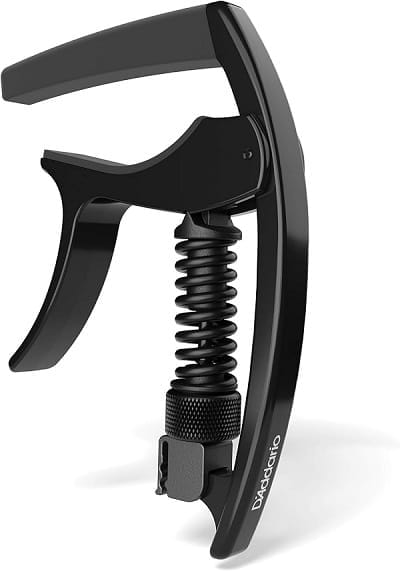
Reason to Buy
Lightweight Construction: Because it is composed of aircraft-grade aluminum, the D’Addario NS Classical Capo is remarkably thin and subtle on the neck of the guitar.
Trigger Mechanism: The capo is incredibly simple to use with one hand thanks to its unique trigger mechanism, which drastically lowers the force needed to open and close it. This is particularly beneficial for classical guitarists who often need to switch between different frets quickly and smoothly.
Micrometer Tension Adjustment: The D’Addario NS Classical Capo features a micrometer tension adjustment mechanism that allows for precise control over the pressure applied to the strings.
Reson to Avoid
May Not Fit All Fretboards: While the D’Addario NS Classical Capo is designed for classical guitars with flat fretboards, it may not fit perfectly on some guitars with extremely wide or curved fretboards.
Dunlop 88N Trigger Classical Guitar Capo
The Jim Dunlop 88N Trigger Classical Capo is tailored for classical guitarists who seek a reliable and efficient capo. This capo is built for classical guitars with flat fingerboards. It clamps your strings securely and accurately, and its low-profile design keeps your fingers clear so you may play comfortably.
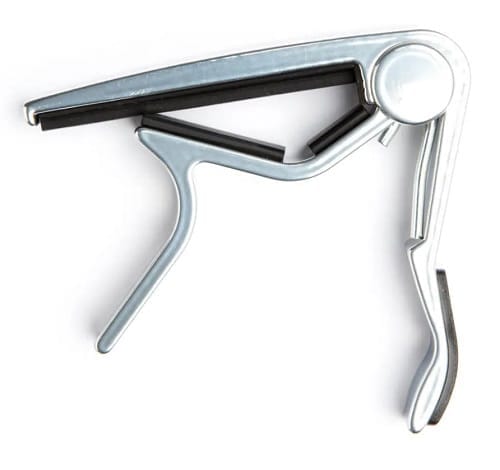
Reason to Buy
Scratch-Free and Low-Profile Design: The 88N Trigger Classical is engineered to be gentle on your guitar, offering scratch-free performance.
Lightweight and Durable Construction: Made from quality aircraft aluminum, the capo is both lightweight and durable. This means it adds negligible weight to the neck of the guitar, maintaining the instrument’s balance.
Spring-Loaded Design: The capo’s spring-loaded design ensures that even pressure is applied across the fretboard, effectively clamping down on the strings without overdoing it.
Reason to Avoid
Potential for Uneven Pressure: While designed for flat fingerboards, the trigger-style mechanism may sometimes apply uneven pressure across the fretboard, especially on classical guitars with wider necks.
Shubb C2B Original Guitar Capo
Doing justice to its name, the Shubb C2b Original Capo features a classic Shubb design that has been popular for over thirty years. It stands out with its patented locking action, which ensures smooth and easy operation.
The capo’s design mimics the natural action of a fingertip and hand, allowing it to apply pressure without displacing the guitar strings, thus eliminating the need for retuning. This model is crafted from plain brass, offering a vintage, rustic look, which can be polished to a gold-like shine.

Reason to Buy
Patented Locking Action: The Shubb C2B features a patented over-center locking action, which provides a smooth and easy operation.
Mimics Fingertip Pressure: The capo’s soft rubber pad is designed to work like a fingertip. This design allows it to apply pressure to the strings in a way that’s similar to how a finger would, thus reducing the risk of bending strings out of tune.
Vintage Aesthetic with Brass Construction: Made from plain, non-plated brass, the Shubb C2B has a vintage, rustic appearance that appeals to many guitarists. The brass construction not only adds to its aesthetic charm but can also be polished to a shine, offering versatility in appearance.
Reason to Avoid
Manual Adjustment Required: Unlike some modern capos that offer quicker, one-handed operation, the Shubb C2B requires manual adjustment for securing it onto the guitar. This can be less convenient for those who prefer quick changes, especially during live performances.
Flanger FC-03 multi-function capo
Different Types of Classical Guitar Capos
An array of capos specifically designed for classical guitars are available, each offering unique features and advantages. Let us explore a few notable options:
G7th Capos
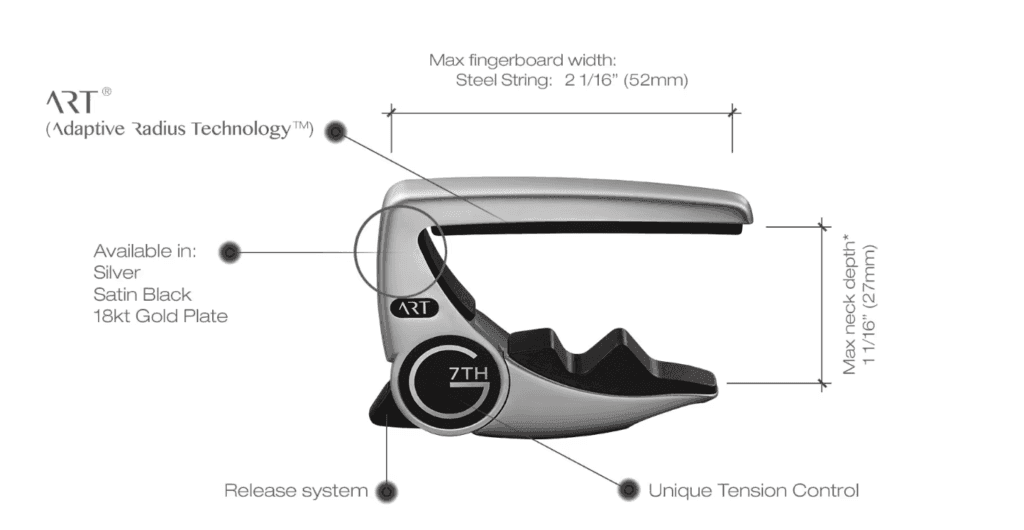
In my personal experience, I have found the G7th Capo to be a game-changer. Its innovative design allows for seamless, one-handed operation, making it incredibly convenient during live performances or situations where quick adjustments are required. The consistent pressure it provides across the fretboard ensures impeccable intonation, preserving the natural tone of my classical guitar. The G7th Capo has truly elevated my playing experience for both nylon string and steel string guitars.
Trigger Capo
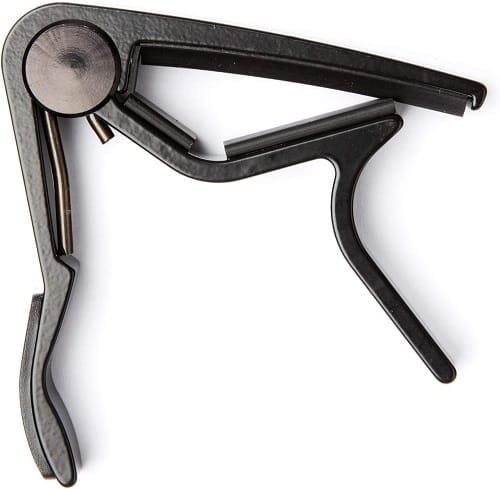
Having tried various regular as well as classical guitar capos, the Trigger Capo has become my go-to choice. Its spring-loaded mechanism makes it incredibly easy to attach and adjust, saving me valuable time during performances. The convenience and ease of use it offers are unmatched. I also appreciate the reliable pressure it applies to the strings, ensuring accurate intonation and allowing me to maintain the desired tonal qualities of my classical guitar.
Screw Capo
When it comes to precision and customization, the Screw Capo has proven to be an invaluable tool. The screw mechanism allows me to finely adjust the capo’s pressure to suit my personal preferences. This level of control ensures optimal tension without compromising intonation or causing any buzzing. The Screw Capo empowers me to fine-tune my classical guitar’s sound, enhancing my playing experience with its tailored approach.
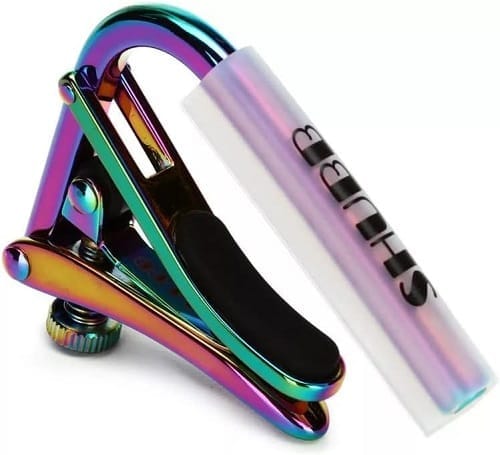
Cradle Capo
The cradle capo stands out among capos for classical guitars due to its unique design and practicality. It uses a suspended bar to gently hold down the strings, ensuring precise pressure and maintaining accurate pitch. This innovative approach allows for excellent intonation control while minimizing buzzing or muted notes.

The cradle capo’s gentle touch and reliable performance make it an ideal choice for classical guitarists who prioritize flawless intonation and the natural resonance of their instrument. With its versatility and user-friendly design, the cradle capo has significantly enhanced my playing experience on the classical guitar.
Partial Capo

Embracing creativity and experimentation, the Partial Capo has become an essential tool in my arsenal. Its unique design, selectively covering a subset of strings, opens up a world of possibilities. With the Partial Capo, I can create distinctive chord voicings and explore unconventional tunings while maintaining open strings for added depth and richness. It has expanded my creative horizons, allowing me to craft unique compositions that truly stand out.
What types of capo should I prefer? Spring or Micrometre
Choosing between a spring capo and a micrometer (screw) capo involves considering several factors related to your playing style, the type of guitar you use, and your specific needs. Both spring and micrometer capos have their own advantages and disadvantages. The best type of capo for you will depend on your individual needs and preferences.
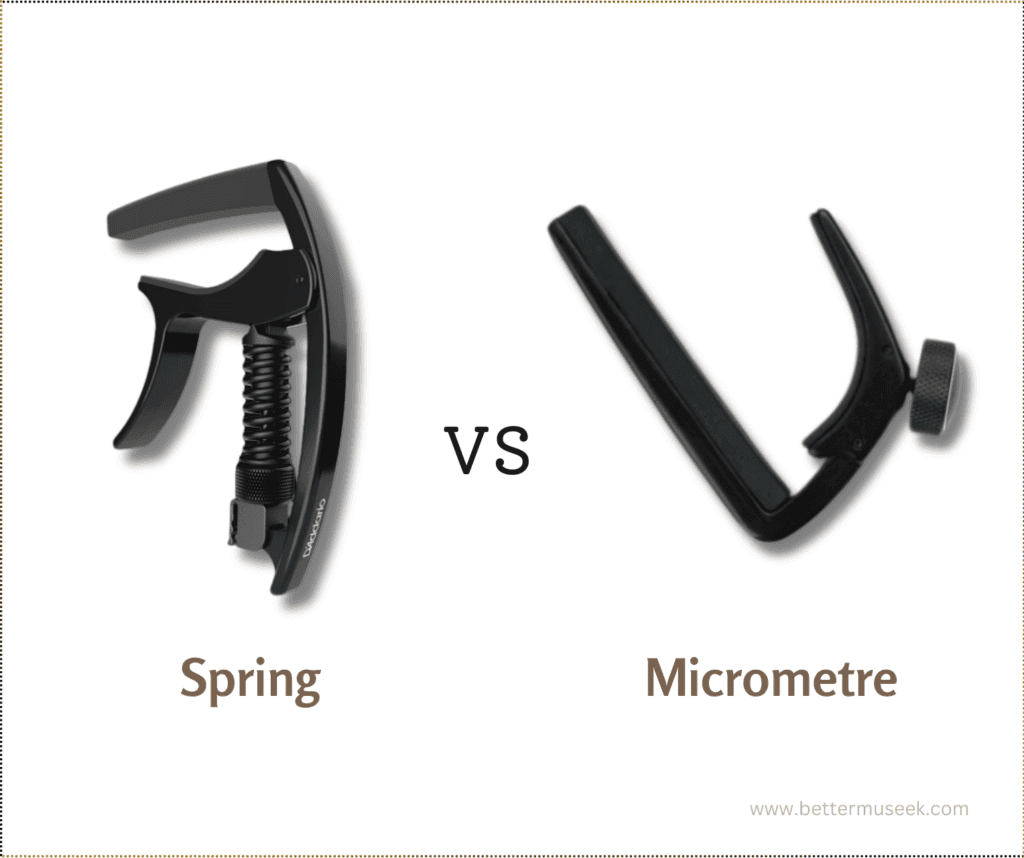
Spring capos are the most common type of capo. They are easy to use and relatively inexpensive. However, they can sometimes put too much pressure on the strings, causing them to buzz.
Micrometer capos are a more expensive type of capo, but they offer more precise control over the tension on the strings. This can help to eliminate buzzing and improve intonation.
Here is a table summarizing the pros and cons of each type of capo:
| Type of capo | Pros | Cons |
| Spring | Easy to use, inexpensive | Can cause buzzing, Potentially Wear |
| Micrometer | Precise control over tension eliminates buzzing, improves intonation | More expensive, Slower Adjustment. |
What Should You Look For Before Buying a Classical Guitar Capo?
Here are some things to look for when buying a classical guitar capo:
Fit: Classical guitars have flat fretboards, so you need a capo with a flat pad. Some capos are designed specifically for classical guitars, while others can be used on both classical and acoustic guitars. Make sure the capo you choose fits snugly on your guitar neck without being too tight.
Tension: The capo should apply even pressure to all of the strings without fretting them out. If the capo is too tight, the strings will go sharp. If it’s too loose, the strings will buzz. Look for a capo with a spring-loaded mechanism or a thumbscrew that allows you to adjust the tension.
Ease of use: The capo should be easy to put on and take off, and it should stay in place securely while you’re playing. Avoid capos that are difficult to position or that tend to slip out of place.

Image by Daddario
Durability: The capo should be made of durable materials that will withstand regular use. Avoid capos that are made of cheap plastic or other materials that are likely to break easily.
Price: Set a budget and find a capo that offers the features you need within that range. High-quality capos are available at various price points.
Brand Reputation: Consider purchasing from reputable brands or manufacturers that produce reliable guitar accessories.
Check out more Classical Guitar Accessories.
Why do you need to be careful about a classical guitar capo?
Using a classical guitar capo demands meticulous attention due to the instrument’s distinctive characteristics. Inaccurate capo placement or uneven pressure on the strings can result in intonation issues, significantly compromising the precision of pitch across the fretboard.
The tension-related challenges inherent in classical guitars, characterized by their lower string tension compared to electric guitars or steel-string acoustics, can have a detrimental impact on both playability and sound quality when employing a capo.
Since we are talking about guitar strings, why don’t you check out the list of the best classical guitar strings we made?

Another critical concern is the potential occurrence of fret buzz, an irksome buzzing sound that can arise when employing a cheap or poorly constructed capo with insufficient padding. Such an occurrence is not only distracting but also diminishes the overall clarity and resonance of the classical guitar, adversely affecting the instrument’s tonal qualities.
Conclusion
Alright, so I’m wrapping up everything about classical guitar capos. Picking the right capo is super important for your classical guitar adventures. You’ve got options like the micrometer capo for when you want to nail that tension control or the spring capo for when you need to switch it up fast and easily.
It’s not just about clamping it on; it’s about how it affects your sound, keeps your tuning in check, and feels on your guitar. Also, when choosing a capo, it is important to consider the type of guitar you play, your playing style, and your budget. Spring capos are the most common type of capo and are easy to use and inexpensive.
FAQs of Classical Guitar Capo
Yes, you can play without a capo. A capo is a device that clamps onto the fretboard of a guitar, raising the pitch of all the strings by a specified number of semitones. This can be useful for playing songs in a different key without having to learn new chord shapes. However, you can also play any song in its original key without using a capo. To do this, you will need to use movable chord shapes, which are chord shapes that can be moved up or down the neck without changing the fingering pattern.
Yes, you can use a classical capo on an acoustic guitar. Classical capos are designed to be used on nylon-string guitars, which have a wider fretboard than steel-string guitars. However, you can also use a classical capo on a steel-string guitar, as long as the capo is not too tight. If the capo is too tight, it can damage the strings or the neck of the guitar.
No, capos are not only for beginners. Capos can be useful for guitarists of all levels of experience. They can be used to play songs in a different key without having to learn new chord shapes, to adjust the pitch of a song to match the vocal range of a singer, or to create a different sound for a particular song.
- Budget Classical Guitars Under $700 - February 15, 2025
- How To Set Up A 12-String Guitar Perfectly - September 8, 2023
- Vibrato Techniques: A Comprehensive Guide - September 6, 2023

